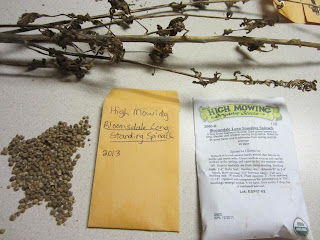Jon and I began seed saving last year and want to share with you how we make our own packets for storage. Some gardeners I have talked to save their own seeds and others think it's not worth the time because seeds are relatively cheap; after all, some crops such as carrots, beets, and leeks take 2 growing seasons to produce seeds. One perk to letting some plants go to seed is that more color and beauty is added to the garden attracting beneficial insects and pollinators such as honeybees. One plant going to seed in our garden right now is leeks. They are absolutely beautiful! They produce colorful globes that are about 5 feet tall and sway in the wind (picture below) - they look just like globe allium except you get the benefit of them being edible. Saving seeds also gives a gardener food security and lets the gardener pick and choose seeds from the most prolific plants or from plants that have enhanced genetics that make them resistant to certain bugs, or fruit earlier, or have sweeter fruits, or blossom later to avoid spring frosts. It's all in the seed. Saving them from your garden will ensure you have the best genetics targeted for your exact garden and climate.
What do think about saving seeds? What is your main reason for saving seeds or not to save them?
Please leave a comment below.
Homemade Seed Packets
Updates at the Wolfe House
It's been awhile since I gave a general update of what's been going on around here so I've been taking pictures the past 2 weeks so you can see what we're up to.
Fall & Winter 2012 Woodworking Projects



Labels: Waste , Woodworking
Beets Grow Better with Cow Manure
Last spring we ordered 5 tons of cow manure from a local farmer. In the fall we added the manure to the garden and rotor-tilled it this spring. What a difference this manure has made! Check out the pictures below, click to enlarge them.
Labels: Garden
Homemade Strawberry Soda
Our strawberry patch is producing really well for its 2nd year and we are busy filling bags for the freezer, making jam, strawberry wine, and soda! I included step-by-step instructions on how to make strawberry soda so you can enjoy a homemade beverage right at home. This recipe can be adapted for all berries.
Labels: Fermentation , Fruit , Garden , Homemade Soda , Recipes












































